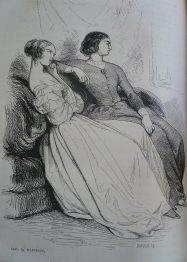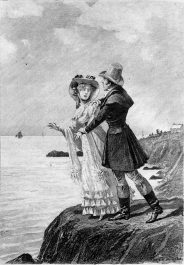
Beatrix III
THE HUMAN COMEDY – Honoré de Balzac Fourth volume of works of Honoré de Balzac edited by widow André Houssiaux, publisher, Hebert and Co, successors, 7 rue Perronet – Paris (1877) Scenes from private life

Béatrix and Camille

Calyste reunites with Beatrix
BEATRIX (part 3)
Preface and history Un adulère rétrospectif is a novel Balzac wrote in 1845 as a sequel to his long two-part novel Béatrix, which he had published two years earlier. This sequel had been promised. But in recent years, Balzac’s novels had become such vast frescoes that Balzac had taken to presenting the most important of them as successive sets of novels, published over several years. This was the case forIllusions perdues, whose publication was extended over seven years. Splendeurs et misères des courtisanes, which took eight years to complete. Béatrix is one of these sets, less complex than the previous two. Readers of Béatrix were already familiar with the characters’ situation, as recalled at the start of this sequel. Calyste du Guénic, young heir to an old Breton family, has just married Sabine de Grandlieu. It’s a rescue. Calyste, twenty-four years old, angelic beauty, Breton fervor, nearly commits suicide after an ill-fated love affair with Countess Béatrix de Rochefide. Sabine knows it. 1 st act: La lune de miel (The Honeymoon) was the original title of the novel. We know what happened from Sabine’s letters to her mother, the Duchesse de Grandlieu. It’s a lovely phase of the novel. Sabine adores her husband, and she loves Brittany, where the peasants welcome the young couple visiting their land as if it were still the time of François 1er. But she’s too much in love to be coquettish, too young to outwit the traps, too sweet not to be a slave. She feels it all. She feels that it is she who loves and that her handsome Calyste lets herself be loved. Two years pass: she has a child, they live in Paris. 2 th act: A retrospective adultery. Calyste meets Béatrix by chance in a box at the Variétés. She’s free, no love, no husband. She makes short work of the innocent Calyste, who is as clumsy as he is handsome. Calyste is drunk with his great love, a coward because he’s in love, a cad because he’s unconscious. Sabine, who nurses, has a serious crisis, and we fear for her life. The pious duchess devises a plan to separate Calyste and Beatrix. 3 th act: Les petits manèges d’une femme vertueuse, which was originally another title of the novel that was not retained. It’s the preparation and denouement of the conspiracy, a real Molière comedy, which takes place in the homes of the demi-mondaines who, at the same time, provided the figuration for Splendeurs et misères des courtisanes. It mobilizes many of the young “lions” of the Comédie Humaine and a few comparses drawn from the basements of Scènes de la vie parisienne or Scènes de la vie de province. At first, it’s a comedy of manners, amusingly depicting Count Arthur de Rochefide’s profound happiness at being rid of his seductive wife and enjoying a cock-a-doodle-doo life in the false household he’s arranged with a chubby, quick-witted concubine. The Duchesse de Grandlieu’s plan was simple: marry Madame Schontz, a petite bourgeoise and mistress of Count Arthur de Rochefide, to Judge Fabien du Ronceret, a native of Alençon and son of a president of chamber at the royal court. Convince Count Arthur de Rochefide to allow his wife to regain her fortune so that the world would not believe she had attacked Calyste. The Comte de La Palférine is paid to seduce the Countess Béatrix de Rochefide and lure her away from Calyste. Everything goes according to plan: Béatrix rejects Calyste for La Palférine. We witness Calyste’s degradation, his cowardice and his return to his wife. This end of the story shows us that Balzac is in a hurry, and the director of the whole affair looks a little too much like Scapin. But at last, things are looking up. Calyste learns of the sad decline of the great loves of the imagination, Mme de Rochefide returns to her husband: and Sabine returns to hers, consoled, but not quite as happy as at the end of a fairy tale. Un adulère rétrospectif is an uneven novel, with touching parts – Sabine’s love, her illusions, her lucidity, her courage as a loving young woman – and ruthless parts, such as Calyste’s fall from grace and his capitulations, and an amusing ending at first, then a botched one. The conditions under which we write explain these inequalities. Conceived early in 1844 as a short story, then delayed and transformed into a novel because of a treaty promising delivery by November 15, it was not begun until December, to appear as a serial in the Messenger from the 24th, an imperative date because of re-subscriptions. A few days before this date, Balzac announced to Madame Hanska that it would take him eight days to write it. In fact, the serial had to be interrupted several times, lasting until January 24, 1845. These were not excellent working conditions. As in the first two parts of Béatrix, Balzac worked from life. In these first two parts, Liszt’s affair with Mme d’Agoult provided the subject matter. In this third part, he was inspired by the misfortunes of Delphine de Girardin, cheated on by her husband after just a few months of marriage. He had asked her for confidences. She was the model he followed. He probably had another to describe Arthur de Rochefide’s cozy life with his chubby mistress. He was never found. But his own situation, with Mme de Brugnol living with him and entertaining as if she’d been the mistress of the house, gave Balzac a few ideas. Calyste’s degradation, the cowardice of his sensual love, this transformation and subsidence of a naturally noble being form the most enigmatic part of the novel. This degradation, says Julien Gracq, is a punishment that “comes out of the very act of prolonged sin”. And, he sees in this abasement and sadness an echo of the punishments Dante imagined for his damned. This interpretation transforms into a mystical thought what was for Balzac the dramatic term of the opposition he had wanted to show in the first part of Béatrix between the Guérande side and the century side. Vanity and passions first profane, then destroy. Calyste’s fall is a denouement. We also find another moral, the one Balzac had set out two years earlier in Mémoires de deux jeunes mariées. It is summed up here in one sentence, which is the real conclusion. “Love is not the goal, but the means of the family; excessive passion is unfruitful and deadly.” It’s the old duchess who utters this moralistic phrase. In this respect, she is Balzac’s mouthpiece. 1838 – 1844 
Preface from Volume V. compiled from the complete text of the Comédie Humaine published by France Loisirs 1985 under the auspices of the Société des Amis d’Honoré de Balzac.
Genealogy of characters The genealogy of the main characters can be seen in parts I and II of Beatrix on this site. Nevertheless, we will indicate hereafter the new characters who appear in volume III of this volume V, namely : Count Rusticoli: Rusticoli de la Palférine, Italian noble family established in France, represented by : a count who, under Louis XV, entertained Mlle Laguerre (actress and owner of Les Aigues); a general who died in 1809 and married a Capponi ; Gabriel-Jean-Anne-Victor-Benjamin-Georges-Ferdinand-Charles-Edouard Rusticoli, comte de La Palférine, born 1812. Maxime de Trailles: born around 1792 – married a woman we have every reason to believe was Cécile Beauvisage, born in 1820. Mrs. Schontz: Aurélie Schontz, whose real name was Joséphine Schiltz, was a lady-in-waiting born in 1805. Around 1841, she married magistrate Fabien du Ronceret.
Character genealogy source: Félicien Marceau “Balzac et son monde” Gallimard.
No Comments